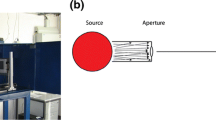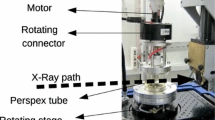Abstract
X-ray tomographic microscopy (XTM), utilizing intense, highly collimated synchrotron radiation, has been used to nondestructively image materials structures in three dimensions. The spatial resolution of the technique approaches that of conventional optical microscopy, but XTM does not require polished surfaces or serial sections. We present the results of an XTM investigation of a composite material composed of silicon-carbide fibers in an aluminum matrix. The results reveal the aluminum/silicon-carbide interfaces and show microcracks running along many of the interfaces as well as in the matrix. Excellent contrast is observed between the silicon-carbide sheath of the fiber surrounding the graphite core and the coating at the fiber-matrix interface. The sensitivity to small changes in the linear absorption coefficient allows nondestructive imaging of variations in chemistry between graphite and silicon carbide and between silicon carbide and aluminum. The experimentally determined values of the absorption coefficients of these phases are identical to values published in the literature. For the first time, XTM will allow observation of damage accumulation and crack growth during deformation testing. The availability of such data will greatly improve our understanding of failure in advanced materials.
Similar content being viewed by others
References
M. F. Amateau, J. Composite Mater. 10, 279 (1976).
G.T. Herman, Image Reconstruction from Projections: The Fundamentals of Computerized Tomography (Academic Press, New York, 1980).
Q. C. Johnson, J. H. Kinney, U. Bonse, and M. C. Nichols (Proc. Mater. Res. Soc. Symp.) (Materials Research Society, Pittsburgh, PA, 1986), Vol. 69, p. 203.
J. C. Elliott and S. D. Dover, J. Microscopy 126, 211 (1982).
J. C. Elliott and S. D. Dover, J. Microscopy 138, 329 (1985).
F. H. Seguin, P. Burstein, P. J. Bjorkholm, F. Homburger, and R. A. Adams, Appl. Opt. 24, 4117 (1985).
S. R. Stock, A. Guvenilir, J. C. Elliott, P. Anderson, S. D. Dover, and D. K. Bowen, in Advanced Characterization Techniques for Ceramics (American Ceramic Society, Westerville, OH) (in press).
M. K. Cueman, L. J. Thomas, C. Trzaskos, and C. Greskovich, in Review of Progress in Quantitative Nondestructive Evaluation, edited by D. O. Thompson and Dale E. Chimenti (Plenum Press, New York, 1989), Vol. 8A, p. 431.
J. H. Kinney, Q. C. Johnson, U. Bonse, R. Nusshardt, and M. C. Nichols, SPIE 691, 43 (1986).
U. Bonse, Q. Johnson, M. Nichols, R. Nusshardt, S. Krasnicki, and J. Kinney, Nucl. Instrum. Methods A246, 644 (1986).
J. H. Kinney, Q. C. Johnson, R. A. Saroyan, M. C. Nichols, U. Bonse, R. Nusshardt, and R. Pahl, Rev. Sci. Instrum. 59, 196 (1988).
U. Bonse, R. Nusshardt, F. Busch, Q. C. Johnson, J. H. Kinney, R. A. Saroyan, and M. C. Nichols, Rev. Sci. Instrum. (in press).
T. Hirano, K. Usami, and K. Sakamoto, Rev. Sci. Instrum. (in press).
L. Grodzins, Nucl. Instrum. Methods 206, 541 (1983).
J. H. Kinney, Q. Johnson, M. C. Nichols, U. Bonse, and R. Nusshardt, Appl. Opt. 25, 4583 (1986).
M. C. Nichols, J. H. Kinney, U. Bonse, Q. C. Johnson, R.A. Saroyan, R. Nusshardt, and F. Busch, Rev. Sci. Instrum. (in press).
B. P. Flannery, H. Deckman, W. Roberge, and K. D’Amico, Science 237, 1439 (1987).
The storage ring SPEAR was running at 3.3 GeV and nominally 30 mA. The wiggler field was 1.0 T, only 60% of its rated field strength.
E. F. Plechaty, in “Tables and Graphs of Photon-Interaction Cross Sections,” Lawrence Livermore National Laboratory, Livermore, CA, UCRL-50400, Vol. 6, Rev. 3 (1981).
International Tables for X-Ray Crystallography (Kynoch Press, Birmingham, England, 1972), Vol. 4, pp. 61–66.
The nominal composition of this alloy is from Metals Handbook Desk Reference (American Society for Metals, Metals Park, OH, 1961), 8th ed., Vol. 1, p. 945.
P. Martineau, M. Lahaye, R. Pailler, R. Naslain, M. Couzi, and F. Creuge, J. Mater. Sci. 19, 2731 (1984).
W. G. Friche, Jr., Scripta Metall. 6, 189 (1972).
S. R. Nutt and F. E. Wawner, J. Mater. Sci. 20, 1953 (1985).
B. A. Lerch, D. R. Hull, and T. A. Leonhardt, As-Received Microstructures of a SiC/Ti-15-3 Composite, National Aeronautics and Space Administration, Washington, DC, NASA TM-100938 (1988).
Author information
Authors and Affiliations
Rights and permissions
About this article
Cite this article
Kinney, J.H., Stock, S.R., Nichols, M.C. et al. Nondestructive investigation of damage in composites using x-ray tomographic microscopy (XTM). Journal of Materials Research 5, 1123–1129 (1990). https://doi.org/10.1557/JMR.1990.1123
Received:
Accepted:
Published:
Issue Date:
DOI: https://doi.org/10.1557/JMR.1990.1123




